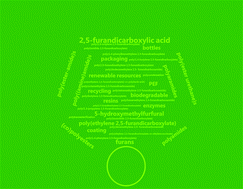Biobased polyesters and other polymers from 2,5-furandicarboxylic acid: a tribute to furan excellency
Abstract
Motivated by the general concern about sustainability and environmental issues, an intense search for renewable-based polymers has grown exponentially in recent years. This search definitely spotlighted polyesters derived from 2,5-furandicarboxylic acid, among other polymers, as some of the most promising, especially due to the resemblance of this renewable monomer to the well-known petroleum-based terephthalic acid, as well as owing to the possibility of preparing innovative materials. The huge number of recent papers and patents about this family of polymers explore aspects as diverse as synthesis with other renewable-based monomers, leading to the preparation of materials with enhanced thermo-mechanical, biodegradability and liquid crystalline properties, among other features. Additional aspects pursued in such studies are innovation in the synthetic approaches or their optimisation, as well as the development of applications for everyday-life objects for example packaging materials, especially bottles, textiles, coating, and toners, among many other uses. Despite this intense activity, little has been reviewed recently about this unique family of polyesters or derived polymers, as the only reviews on the subject date back to the last century. In this perspective, the present review aims at contributing to filling this literature gap, covering recent aspects related with challenges in developing polyesters, polyamides, or other polymers from 2,5-furandicarboxylic acid and their precursors. Emphasis is placed on monomer synthesis, polymerisation reactions, catalysts and applications.


 Please wait while we load your content...
Please wait while we load your content...